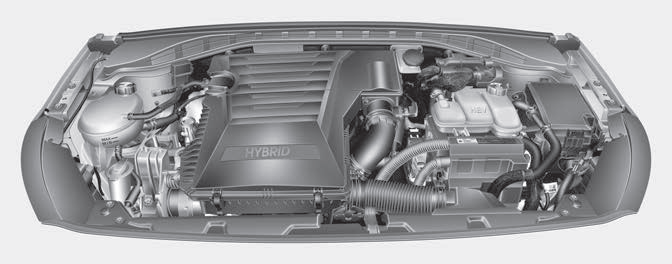Hyundai Ioniq: What to do in an emergency / If the Engine Overheats
If your engine coolant temperature gauge indicates overheating, you experience a loss of power, or hear loud pinging or knocking, the engine may be overheating. If this happens, you should:
1. Turn ON the hazard warning flasher, pull off the road and stop as soon as it is safe to do so.
2. Place the shift lever in P (Park) and set the parking brake.
3. Make sure that there is no hot steam gushing out of the engine compartment. When it is safe to do so, open the engine compartment, and check the water-pump connector. When the water-pump connector is disconnected, stop the engine, re-connect the waterpump connector, and then re-start the engine.
4. Set the temperature and the air flow to the maximum, and turn ON the air conditioner.
5. When the Service warning light ( )
illuminates on the instrument cluster, immediately stop the engine, and contact
an authorized HYUNDAI dealer. When the engine warning light (
)
illuminates on the instrument cluster, immediately stop the engine, and contact
an authorized HYUNDAI dealer. When the engine warning light ( )
illuminates, or when the coolant or hot steams gush out of the engine compartment,
leave the engine compartment opened, while running the engine. This is to ventilate
the engine compartment and to cool down the engine.
)
illuminates, or when the coolant or hot steams gush out of the engine compartment,
leave the engine compartment opened, while running the engine. This is to ventilate
the engine compartment and to cool down the engine.
6. Check the coolant temperature gauge on the instrument cluster to make sure the coolant temperature is sufficiently cooled down. Check the coolant level. When it is insufficient, check its connection with the radiator, the heater hose, and the water pump for any leakage. When there is no leakage, add the coolant. However, if the problems persists, such as the illumination of the warning lights, leakages, or the cooling-fan malfunction, which may overheat the engine, immediately stop the engine, and have your vehicle checked by an authorized HYUNDAI dealer.
WARNING

The electric motor for the cooling fan may continue to operate or start up when the engine is not running and can cause serious injury. Keep hands, clothing and tools away from the rotating fan blades of the cooling fan.
WARNING

Your vehicle is equipped with a pressurized coolant reserve tank. NEVER remove the coolant reserve tank cap or the radiator drain plug while the engine and radiator are HOT. Hot coolant and steam may blow out under pressure, causing serious injury.
Turn the engine off and wait until the engine cools down. Use extreme care when removing the coolant reserve tank cap. Wrap a towel or thick rag around it, and turn it counterclockwise slowly to release some of the pressure from the system. Step back while the pressure is released.
When you are sure all the pressure has been released, continue turning the cap counterclockwise to remove it.
7. If you cannot find the cause of the overheating, wait until the engine temperature has returned to normal. Then, if coolant has been lost, carefully add coolant to the reservoir to bring the fluid level in the reservoir up to the halfway mark.
8. Proceed with caution, keeping alert for further signs of overheating. If overheating happens again, call an authorized HYUNDAI dealer for assistance.
CAUTION
Serious loss of coolant indicates a leak in the cooling system and should be checked as soon as possible by an authorized HYUNDAI dealer.
 Jump starting procedure
Jump starting procedure
1. Position the vehicles close enough that the jumper cables will reach, but
do not allow the vehicles to touch.
2. Avoid fans or any moving parts in the engine compartment at all times, even
when the vehicles are turned off...
Categories
- Manuals Home
- 1st Generation Ioniq Owners Manual
- 1st Generation Ioniq Service Manual
- How to Disconnect Normal Charger
- If the 12 Volt Battery is Discharged (Hybrid Vehicle)
- Washer Fluid
- New on site
- Most important about car
Hybrid Vehicle Engine Compartment

1. Engine oil filler cap
2. Engine oil dipstick
3. Engine coolant cap
4. Engine coolant reservoir
5. Inverter coolant reservoir

